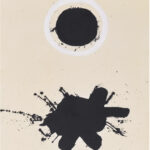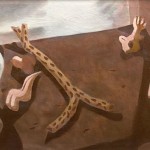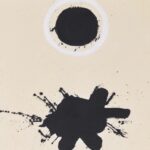Biography
Adolph Gottlieb (1903-1974)
Born in New York City in 1935, Gottlieb was a founding member of The Ten, a group devoted to abstract art with whom he was active for about five years. He became a major exponent of Abstract Expressionism whose painting style is linked to Marc Rothko, Clyfford Still and Barnet Newman. A major theme in Gottlieb’s painting is the challenge to humans to resolve dualities within the universe, the pressure of opposites: male and female, chaos and order, creation and destruction, order and chaos.
His career is described as having four phases: Pictographs (1940s), Grids and Imaginary Landscapes (1951 to 1957), Bursts (1957 to 1974) and Imaginary Landscapes (1960s). Although he lived primarily in New York City and was one of the few Abstract Expressionists born in that city, time spent in Arizona and Provincetown, Massachusetts had a marked influence on him.
Gottlieb studied at the Art Students League with Social Realists John Sloan and Robert Henri, but left abruptly in 1921 for Paris where he enrolled at the Academie de la Grand Chaumiere. Returning in 1923, he lived in New York and developed an interest in primitive sculpture.
He was a WPA mural artist and painted a mural in 1939 for the Post Office in Yerington, Nevada. From 1937 to 1939, he was in Tucson, Arizona, which influenced his subsequent “pictograph” series that occupied him the remainder of his life. The pictographs involved compartmentalized grid divisions of the canvas, primitive iconography and imaginary landscapes and were intended “to evoke mythological responses” (Baigell 141). For him, the time in the Arizona desert was a time of transition from expressionist landscapes to highly personal still lifes of simple desert items such as gourds and peppers. From November 13, 1999 to January 9, 2000, the Tucson Museum of Art held an exhibition, Adolph Gottlieb and the West”, sponsored by the Adolph and Esther Gottlieb Foundation. The publicity described it as “dedicated to more than 50 works from the seminal Abstract Expressionists little-known 1937-1938 stay in the Arizona desert.”
In the early 1950s, he designed a stained-glass exterior, 1,350 square feet, for the Milton Steinberg Memorial Center in New York City. His work was religious in tone but not specifically dogmatic.
Sources include:
Matthew Baigell, Dictionary of American Art
Peter Falk, Who Was Who in American Art
Jessie Benton Evans Gray, exhibition informaton of the Tucson Museum of Art

 Untitled
Untitled
 Still Life – Dry Cactus
Still Life – Dry Cactus
 Untitled
Untitled